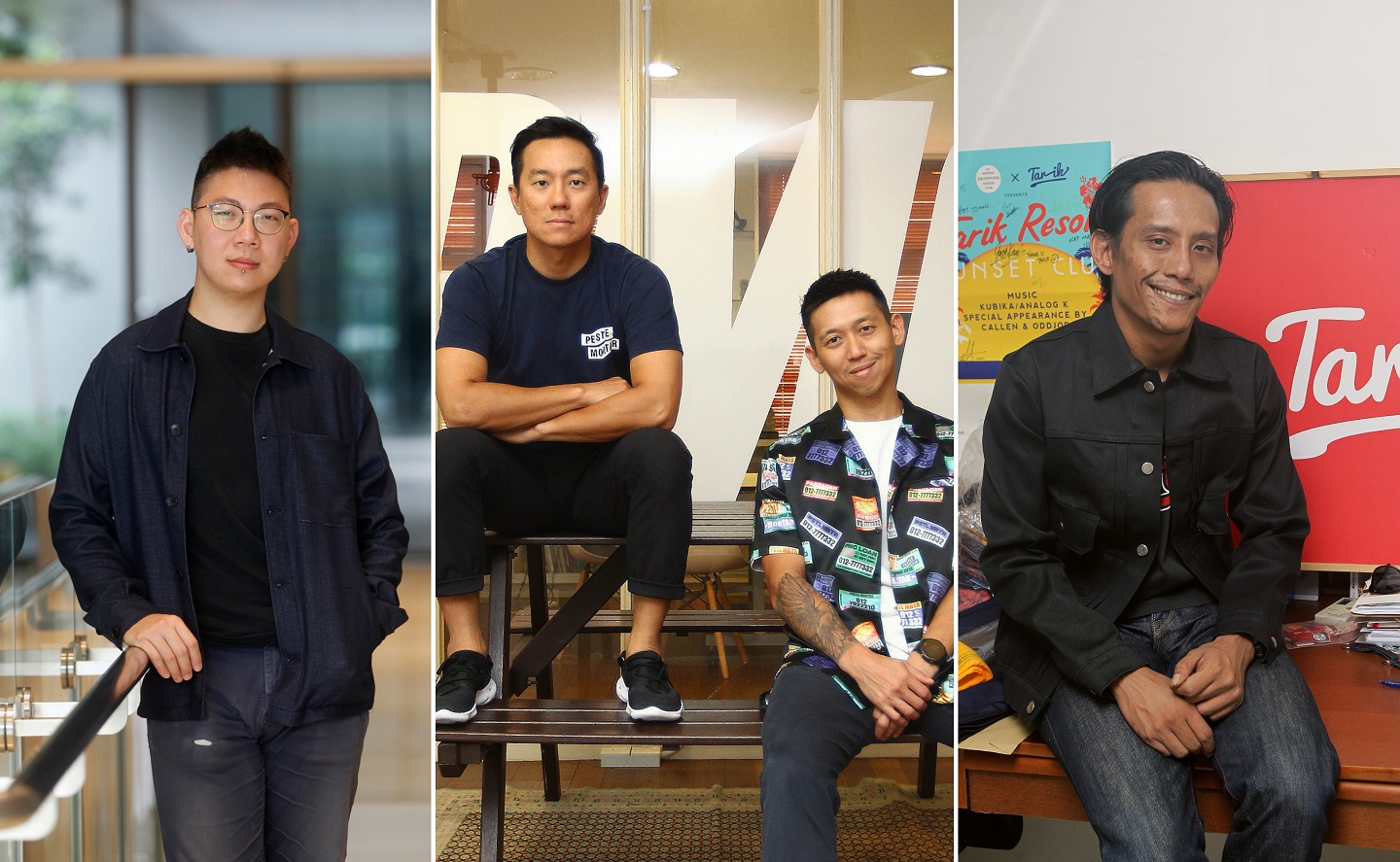
Koh Yung Shen of The Swagger Salon, brothers Mark and Hugh Koh of Pestle & Mortar clothing and Afiq Iskandar Zainal Ariffin of Tarik Jeans (Photo: Mohd Izwan Mohd Nazam, Patrick Goh, Haris Hassan/The Edge)
Pestle & Mortar Clothing, Tarik Jeans and The Swagger Salon began in a time when buying local was not as trendy as it is today. Determined to produce clothing that represented unique Malaysian identities, these brands persevered and are now celebrating a decade in business.
Pestle & Mortar Clothing
For most Malaysians, Pestle & Mortar Clothing is a familiar brand known for its streetwear and youthful sensibilities. “We’ve always stuck to the unique selling proposition of the brand, and that is storytelling. We are a Malaysian streetwear company. Apparel is just our canvas, but the main thing that sets us apart are the stories we tell,” says co-founder and chief vision officer Hugh Koh.
Early on, what made people notice the brand’s aesthetic was how uniquely Malaysian they were. Hugh notes designs such as “Kuala Lumpur” in reverse and images of local delights turned into fun conversation starters that really embodied the local identity. “None of us actually came from a fashion or retail background; we said ‘okay, we can’t really draw, why don’t we take photos of things?’ We used instantly recognisable imagery like the Mamak Indomie on an orange plate with a telur mata or a nasi lemak,” he adds.
In 2014, the company launched Major Drop, a multi-label retail site that carried international brands that were difficult to get in Malaysia, and soon after it even tried its hand at starting a café. Ultimately, it was decided that the Pestle & Mortar Clothing brand should be the focus. More recently, the rise of streetwear styles and labels and their acceptance by mainstream fashion made the founders realise that perhaps a new strategy was required.
20200915_peo_hugh_koh_and_mark_koh_pg-2_2.jpg
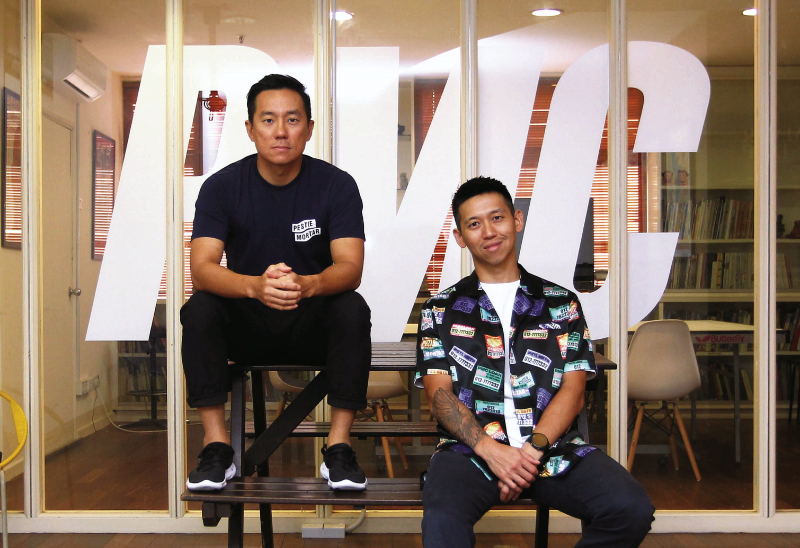
“Collaborations have been a very big part of the brand in recent years. We realised that in the West, many streetwear brands were collaborating with large luxury brands and we thought this could be an interesting trend to start here in Southeast Asia. So, we looked for local partners, and Royal Selangor was our first. That was one of the first successful collaborations that we did,” says Mark Koh, co-founder and chief financial officer. Mark and Hugh are brothers.
The clothing brand managed to keep its momentum over the years because customers really enjoyed the stories told through its designs. “When we started out, it was more a hobby rather than a proper business. We still had our day jobs. As the years passed, we gained confidence. What we try to do is set milestones for the next three to five years and we are hitting them. People love the brand,” Hugh says.
While Pestle & Mortar’s target market is still relatively young — those aged between 20 and 30 — the brothers note that the brand has grown with them. “We evolved the offerings along with our life. Like about six years ago, we started cycling, so we created a cycling kit. We produced running tops because we ran a lot and did triathlons and Ironmans. So, we started bringing in things which resonated with our lives,” says Mark.
To continue to stay relevant to its audience, Pestle & Mortar has a relatively young team who have a handle on the ever-changing fashion trends. “Trends are always changing in terms of silhouettes, materials and colourways. They are always evolving, and have to. Still, people find us relevant and enjoy our sense of nostalgia and heritage,” says Hugh.
pm.jpg

Pestle & Mortar also speaks to our sense of social responsibility, with campaigns such as Darah Tetap Sama Merah, which promotes unity and stands against racism. “Our mum is very involved in social causes, whether it be domestic violence or even politics to some extent. We’ve been very exposed at a young age and that has sort of been translated into Pestle & Mortar, and it will continue to do so. For example, during GE14 (the 14th general election), we actually put out an awareness campaign to tell young people the importance of voting. We did a capsule around the whole campaign,” says Hugh.
To celebrate its 10th anniversary, Pestle & Mortar had an elaborate plan but Covid-19 got in its way. “We had plans for 2020. We actually came up with a campaign called 10 Strong, where we would release 10 different partnerships and collaborations with different brands that either helped us or were tied very closely to what we do. Like AirAsia, a Malaysian brand that has so much presence in Southeast Asia. We managed to do that one but little did we know, the pandemic was around the corner,” says Hugh.
Fortunately, the streetwear line was able to refocus its efforts online and it even recently launched a collaborative collection with Looney Tunes, featuring beloved characters such as Bugs Bunny. We don’t know what the future will bring, but Pestle & Mortar aims to keep telling stories with its creations. “I don’t think we need to be shy about who we are and who we are growing up to be. We still want the brand to resonate with us because that’s where the passion comes from … [People] love the quality and story behind our stuff and I think that’s super important,” adds Mark.
Tarik Jeans
Founder of Tarik Jeans Afiq Iskandar Zainal Ariffin is a creative soul who is very easy-going. “I’ve always had commitment issues, so I’m kind of surprised that I’ve been with Tarik for 10 years already. I didn’t plan it … We go with the flow, and I think that’s probably one of the reasons why we are able to sustain,” he says. Like many businesses, the difficulties of this year have forced Afiq to make difficult decisions like cutting back on staff, and while he was initially disheartened, he strives to keep positive.
Tarik Jeans began quite unexpectedly. As a student of interface design, Afiq’s hobbies included playing music with his band and printing fun designs on T-shirts. On a trip to Bandung, Indonesia, to visit a friend, he was introduced to the impressive quality of craftsmanship in that city. “There were people who turned their homes into makeshift factories to produce clothes on a small scale. My friend was even having jeans made. If you go to a shop in the morning, you can pick up your item in the evening,” he says.
peo_afiq_iskandar_hh.jpg
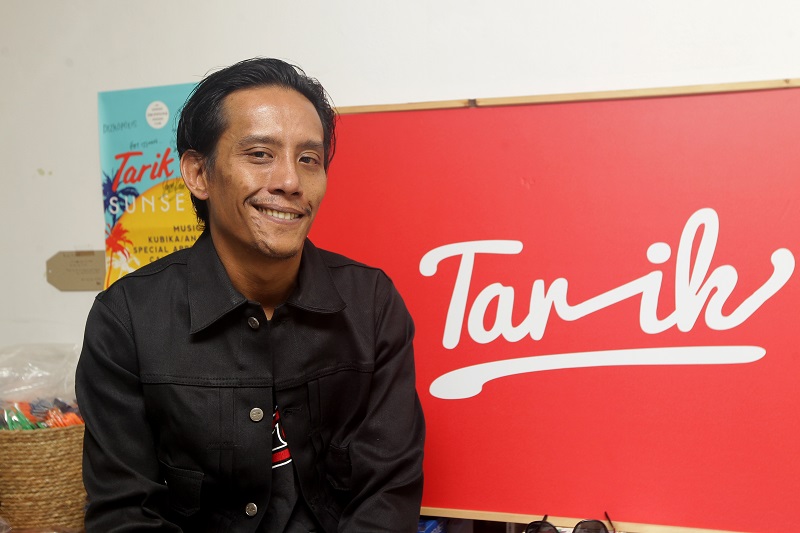
Skinny jeans were all the rage at the time, but Afiq says they were quite inaccessible and many of his friends were buying women’s jeans to get the right fit. He decided to have his own jeans sewn in Bandung. “I became the guy who always had a good pair of jeans on. And then people started asking me to get the jeans for them. I did not know how to measure but I knew how they should look. So that’s how it all started,” Afiq says.
He used to promote his printed shirts and jeans while touring with his band, appealing to a youthful demographic. Since then, the brand has become a popular clothing brand, and while most of the sales are online, it is also available at a few stockists. Tarik Jeans continues to celebrate Malaysian-ness. “The brand’s big idea is to embrace and accept how things are. To own it. A huge part of it has to do with accepting our multi-racial society. That’s why the conversation in Tarik is always about unity. I’ve released T-shirts that say ‘pendatang’ and ‘dan lain-lain’. It’s calling on everyone to just embrace this, we’re all ‘dan lain-lain’,” he says.
This year, Tarik Jeans has collaborated with Volkswagen Malaysia to rescue the Malayan tapir. The clothing brand launched the Modern Nostalgia collection, which includes T-shirts, tote bags and other accessories featuring iconic Volkswagen models and old-school local elements. Part of the profits go to charities such as the Kenaboi Forest Reserve in Negeri Sembilan. “Just after the campaign took off, Covid-19 happened. We were supposed to have a few on-ground events with decorated Volkswagen cars. We only managed two locations,” says Afiq. To continue donating towards this worthy cause, Tarik Jeans recently launched Modern Nostalgia Part Two, with new designs that still capture special elements from both brands.
tarik_jeans.jpg
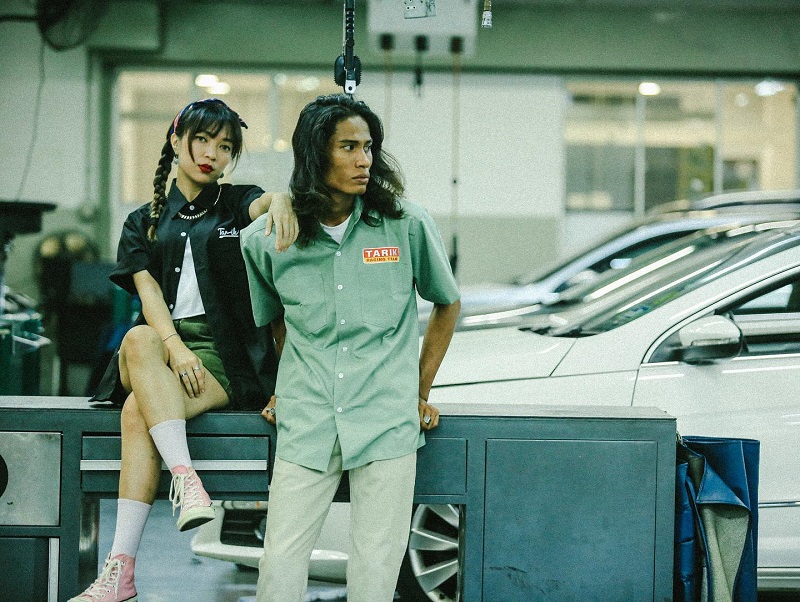
When asked if he believes streetwear is a trend that will always be popular, Afiq says, “Let’s go back to the 1970s, when bell-bottoms were the thing. They were the norm, and even parents were wearing them. So, what we are seeing now is that parents are wearing streetwear and something new is going to come along that these streetwear-wearing parents are not going to agree with, which is going to become the norm for their kids. It’s a cycle.”
While Tarik Jeans began because of a trend, over the last 10 years, the brand’s identity has evolved to evoke a more timeless sense of style. “We’re not trying to be trendy. I suppose we are streetwear that has more denim, but we’re also inspired by vintage looks. So, it’s about trying to keep it as classic as possible … I do look at trends but just to observe the language, you know. To see what’s going on and how we can speak that language with our lingo. We see what we can make that will complement the trend, that is still denim, still us. Keeping our Tarik Jeans identity,” Afiq explains.
The Swagger Salon
In his final year of university, Koh Yung Shen decided to take a leap of faith and use RM5,000 from his savings to purchase 300 fitted caps designed by him. “It was that moment when you graduate, and I thought if I don’t do this now, I’m going to get a job and never be able to try it. At that time, fitted caps were from New Era and it was really a hip-hop thing. So I thought, okay, it’s a good idea to make fitted caps because the New Era caps in Malaysia are either fake or very expensive,” he says. And that was how the Lansi (cocky) caps were born.
A rapper himself, Koh was heavily into the local music scene, and other than on Facebook, he managed to sell his wares at hip-hop gigs. But it was not enough. “The whole reason I started The Swagger Salon was because back then, no physical streetwear shops wanted to stock my caps. This was because local brands were considered nothing at the time,” he says. The Swagger Salon began as an online platform to sell his caps, and eventually T-shirts and other apparel and accessories. The brand really took off, and Koh never had to put in any additional investment after his initial RM5,000.
20200915_peo_shen_8134_izw_2.jpg
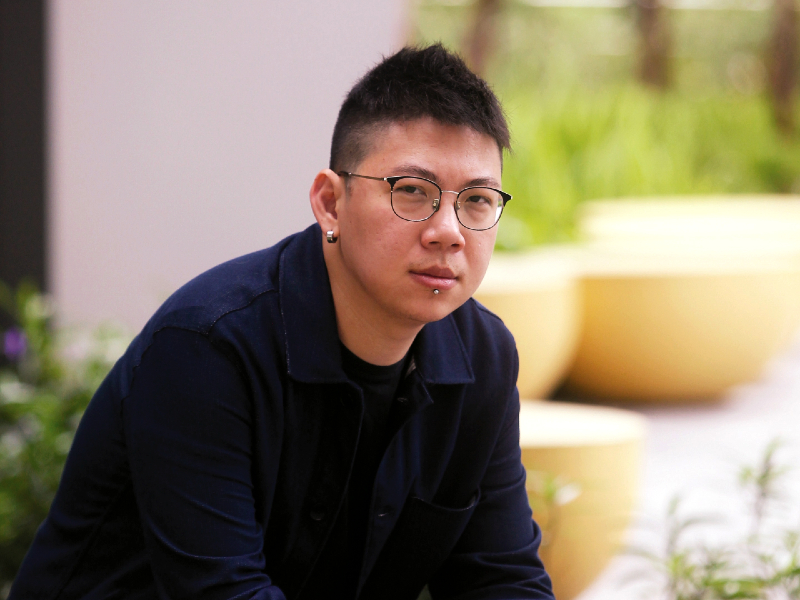
Reluctant to call The Swagger Salon’s sense of style streetwear, Koh explains that 10 years ago “streetwear” did not really exist and it was more a combination of subcultures like hip-hop, skate and surfing. “I don’t really see myself as a fashion designer. I feel like people wear my T-shirts because it’s about making a statement. If you have a nice T-shirt with a fancy design or one with a really funny statement, I would go for the statement tee and I feel like that’s what most people would go for as well. It’s an attitude,” he says.
The Swagger Salon was doing very well until 2016. At that point, Koh had a bricks-and-mortar store in Penang with a team there and another team in Kuala Lumpur. He had to downsize his staff and cut expenses, so now he mostly runs his business from Penang. Koh was also creatively burnt out. “I used to do four collections a year, like every quarter. I felt it was just me giving myself unnecessary pressure, like I was making releases for the sake of making releases. So I decided to change that. I decided to just go with ideas instead, like think of one idea and release a collection surrounding that,” he explains.
Around this time, Koh also decided to try his hand at something new. “I only renovated the front part of the shop in Penang back then because that was all I could afford to do. Two years later, I had enough money to continue the renovation, so I thought, why not make a cocktail bar?” he says. He began the Backdoor Bodega, a fun speakeasy behind his clothing store that allowed him to creatively explore another avenue and helped him recharge before focusing on The Swagger Salon again. It also helped with the store’s overheads as the rent and utilities were now split in two.
the_swagger_salon.jpg
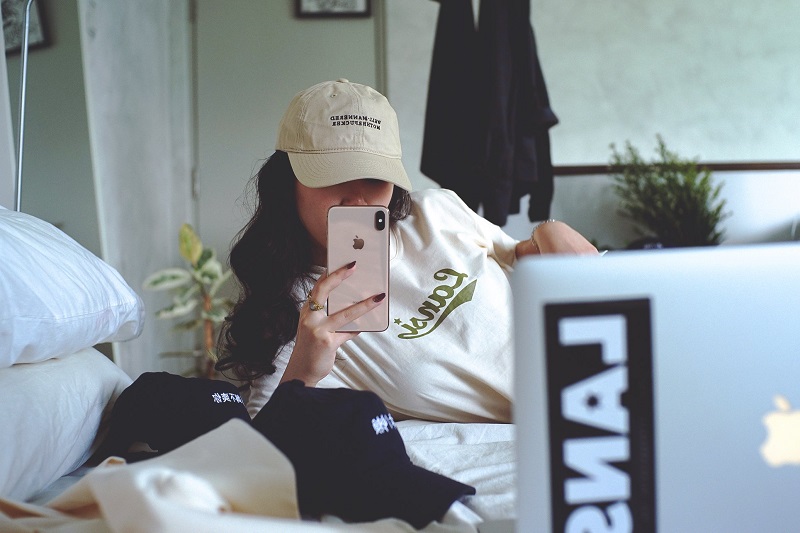
The clothing brand’s sense of style also evolved and matured with Koh. “It went from something loud and obnoxious to being a bit more subtle, not necessarily in design but in terms of the ideas. It takes a bit more thinking, has more layers. For example, this year’s collection is ‘it’s a nice time to be alive’. So, it’s still about an attitude in the way you see things. You can see things in a snarky way or as something positive because you are still alive.”
The Swagger Salon’s unexpected demographic is perhaps what has kept its popularity going. Koh says his customers are not defined by age or location. “We have customers who have been with us for the past 10 years, who still layan the stuff that we put out there — and they are not streetwear people. They are sometimes dads and mums. My greatest joy is when the customer comes in, looks at a T-shirt and laughs because they get it,” says Koh.
This year, he had hoped to celebrate The Swagger Salon’s 10th anniversary (11th for the Lansi caps), but Covid-19 struck. Still, once the movement restrictions were relaxed, he managed to release one of the two collections he had planned to launch this year. The second will be available by the end of the year. In future, when the pandemic is less of a concern, he intends to focus more on his bricks-and-mortar space to create a more comprehensive experience. “A salon is where you go and make yourself look good. The Swagger Salon is the same thing but with clothing. So, I thought I should kind of revisit the whole idea and make the store a bit better,” he says.
This article first appeared on Nov 16, 2020 in The Edge Malaysia.


